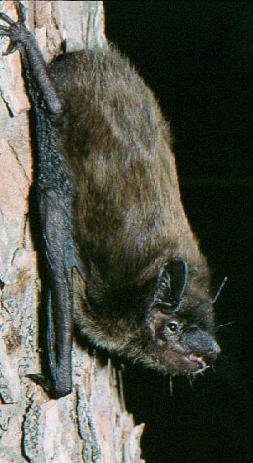Evening Bat (Nycticeius humeralis)

TPWD ©
- Protection Status Notes
- Evening bats have declined in Indiana, but it appears to be relatively abundant in Missouri and Iowa. Its population trends have not been monitored, and its status is unknown over much of its range. N. humeralis is not listed as a species of special concern by the U.S. Fish and Wildlife Service, though it is considered endangered in Indiana, the area where it has been best monitored.
- Description
- Nycticeius humeralis is a small, dark brown bat with black wings and ears. Its fur is bicolored above (dark brown at the base and dull grayish brown at the tips) and lighter brown below. The tail is furred only at the base of the upper side. It has a forearm length of 34-38 mm and weighs 8-14 g. The evening bat is very similar to the big brown bat due to its fur color and broad muzzle. However, it is much smaller (forearm less than 40 mm) and does not have a keeled calcar. The evening bat's rounded tragus distinguishes it from all other small bats except the eastern pipistrelle, which has tri-colored rather than bicolored dorsal fur. The evening bat also has just two upper incisors instead of the four typical of all myotis.
- Life History
- The Evening Bat is a colonial species that is believed to migrate south in the fall. It builds substantial fat deposits in late summer and periodically falls into torpor in winter. Mating occurs in the fall. Females give birth in late May or early June to two or sometimes three pups. These pups are born pink and hairless with their eyes closed, yet are capable of flight within 20 days. They are nearly adult size at one month and within six to nine weeks they are completely weaned. Some communal nursing occurs while the pups are still learning to forage on their own. Young males immediately leave the maternity roost once they are weaned, but females continue to forage with their mothers. During summer and early fall, adult males are solitary and little is known about their habits. The Evening Bat has a relatively short life span for a small insectivorous bat, apparently living about two to five years. In spring, females form maternity colonies of 25 to 950 individuals.
The Evening Bat leaves northern parts of its range in winter, suggesting a fall migration to southern states. Banded individuals have been found as far as 340 miles south of banding sites, yet their destinations remain undocumented. The Evening Bat is a relatively slow and steady flyer that feeds high in the early evening and comes lower after dark. In cooler weather, Evening Bats feed only once per night. A colony of 300 Evening Bats was estimated to consume 6.3 million insects per summer, dining mainly on spotted cucumber beetles. - Habitat
- The Evening Bat is a forest-dwelling species that roosts in tree crevices and behind loose bark, as well as in buildings. This species rarely enters caves but does participate in swarming activities at some cave entrances in late summer. They historically used tree hollows, but as forests have been cut, many have moved into wooden buildings.
This species prefers to forage along edges of mature forests, in clearings, and over waterways. It eats a variety of beetles including cucumber beetles, Japanese beetles, carabid beetles, and June bugs. This bat also catches flying ants, spittle bugs, pomace flies, stinkbugs, and small moths. - Distribution
- The evening bat lives in eastern deciduous forests, from the East Coast west to eastern Nebraska and south through East Texas to northern Mexico. It inhabits elevations from sea level to 300 m.
This bat is found in the eastern one-third of Texas, west to about Clay County in the north and Kinney County in the south. - Threats and Reasons for Decline
- Loss of old-growth timber has deprived this species of its original roosts, and further losses result when wooden barns and other old buildings are replaced by structures that bats can not use.
- Ongoing Recovery
- Evening bats are highly beneficial consumers of insect pests and they coexist well with humans. Public education and artificial roosts could greatly aid in the protection of this species.
- Other
- Very little is known about this species' migration or winter habitat requirements.
For more information
Refer to the online version of The Mammals of Texas for additional details on the Evening Bat.